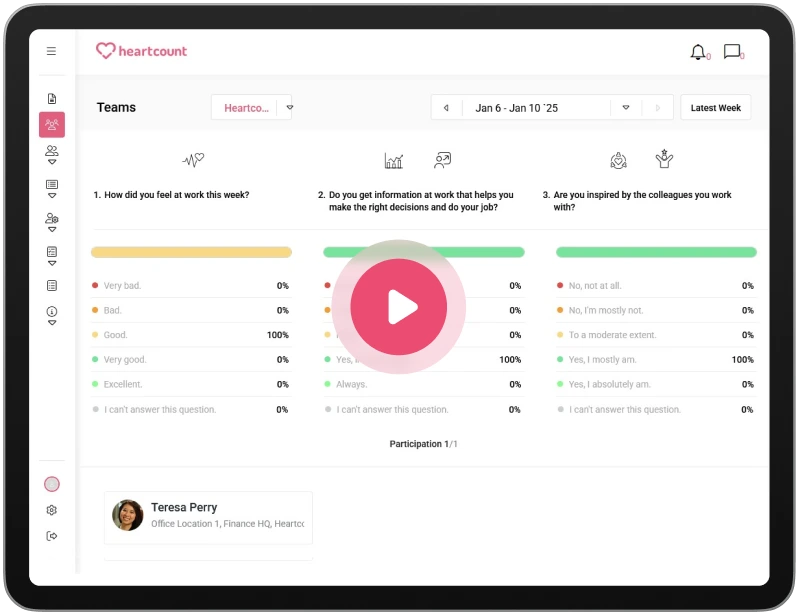5 Signs of career stagnation and tips to overcome it

Career stagnation isn’t just a problem for individual employees—it affects the entire organization. When employees feel stuck or unmotivated, their lack of engagement can spread to their teams. This lowers collaboration, reduces productivity, and hurts workplace morale.
Over time, it can lead to higher employee turnover, less innovation, and a disconnected work environment. Tackling career stagnation is key to keeping employees motivated, engaged, and performing at their best.
Career stagnation isn’t just a problem for individual employees—it affects the entire organization. When employees feel stuck or unmotivated, their lack of engagement can spread to their teams. This lowers collaboration, reduces productivity, and hurts workplace morale.
Over time, it can lead to higher employee turnover, less innovation, and a disconnected work environment. Tackling career stagnation is key to keeping employees motivated, engaged, and performing at their best.
What is career stagnation?
Career stagnation occurs when an individual feels stuck in their job, with no clear career advancement, learning, or growth opportunities. It often results from repetitive tasks, lack of recognition, limited skill development, or a lack of defined career paths within an organization.
It’s like being on a treadmill—you’re working, but you’re not going anywhere.
When employees experience career stagnation, they may feel bored, unmotivated, or even unhappy with their work. It can make them feel like their job is no longer exciting or fulfilling. This can happen to anyone, no matter how long they’ve been working.
Key signs of career stagnation include:
- Feeling unchallenged in your role.
- No opportunities to acquire new skills or responsibilities.
- A sense of being overlooked for promotions or career development.
- Decreased interest in work and professional goals.
Career stagnation isn’t just a problem for the employee—it can affect the entire workplace. When employees feel stuck, they may become less productive or disengaged, which can hurt team morale and company performance.
Recognizing and overcoming career stagnation early is important for both individuals and organizations to take action and improve the situation.
Common causes of career stagnation and how to recognize it
Career stagnation is a challenge that can affect employees across all industries. It not only hampers professional growth but also impacts overall morale and productivity.
Its root causes include:
- Limited career development opportunities. Employees who don’t see clear paths for career advancement or growth may feel stuck in their roles. Without structured programs for career development or opportunities to acquire new skills, they’re left with no sense of progress.
- Poor management. Ineffective managers can fail to provide guidance, support, or recognition. A lack of communication or constructive feedback from managers may leave employees unsure of how to improve or grow within the organization. This often leads to frustration and disengagement.
- Repetitive or unchallenging work. Performing the same tasks repeatedly without variety or challenge can lead to boredom. Employees thrive when they are exposed to new challenges or given chances to innovate and solve problems. Without these, they may lose motivation.
- Lack of feedback and recognition. Feedback is important for personal and professional development. Employees need constructive feedback to understand their performance and grow. Similarly, recognition for achievements increases motivation. A culture where these are absent can breed dissatisfaction.
- Mismatch of skills and roles. Employees who work in positions that don’t align with their abilities or interests often feel unfulfilled. Over time, this misalignment can lead to a lack of engagement and a sense of stagnation.
- Workplace culture issues. Toxic or unsupportive work environments can erode enthusiasm. A lack of collaboration, poor communication, or an absence of belonging makes employees feel isolated, further contributing to stagnation. Promoting a culture of belonging can help.
It’s important to recognize the early warning signs of career stagnation so it can be addressed before it impacts overall productivity:
- Disengagement: Employees may seem uninterested in their tasks or avoid participating in team activities.
- Lack of enthusiasm: A noticeable decline in energy, motivation, or initiative to take on new projects.
- No pursuit of career growth: Employees stop seeking promotions, training, or other professional development opportunities.
- Decline in productivity: Stagnation often correlates with reduced output and quality of work.
- Resistance to change: Employees stuck in stagnation may resist taking on new responsibilities or challenges.
Organizations can use employee experience management software to detect and address career stagnation. Features such as pulse checks and custom surveys provide insights into employee sentiment, helping managers identify issues before they escalate.
Pulse checks are frequent, short surveys that measure employee engagement and satisfaction, while custom surveys assess specific areas such as career growth opportunities or managerial effectiveness. Companies can gather insights and create actionable strategies to encourage career development, improve employee satisfaction, and build a thriving workplace.
The impact of career stagnation on employees and organizations
Career stagnation is not just a personal struggle for employees—it also has significant repercussions for organizations. When left unaddressed, it can ripple through an entire workplace, reducing morale, productivity, and long-term success.
Impact on employees
- Decreased motivation and engagement. Employees who experience career stagnation often lose their drive to excel. Without opportunities for career growth or challenges that encourage them to develop new skills, they may feel disconnected from their work and goals.
- Increased risk of burnout. Repetitive, unchallenging tasks can lead to emotional and mental exhaustion. Burnout is particularly common in roles where employees feel stuck with no clear career path or recognition for their efforts.
- Diminished self-worth and job satisfaction. A lack of progress can make employees question their abilities and contributions. Over time, this erodes job satisfaction, leaving employees feeling undervalued and unfulfilled.
- Higher likelihood of leaving the company. When employees see no prospects for career advancement, they may seek opportunities elsewhere. High turnover not only disrupts teams but also forces organizations to spend resources on hiring and training replacements.
Impact on organizations
- Decline in productivity. Stagnant employees are less likely to be proactive or innovative, which directly impacts overall team performance. This lack of engagement can reduce the organization’s ability to meet goals effectively.
- Lower team morale. Career stagnation often affects more than just the individual. Disengaged employees can influence team dynamics, spreading negativity and diminishing morale.
- Reduced retention rates. Employees who feel stuck are more likely to leave, creating instability and increasing recruitment costs. Organizations may struggle to retain top talent, leading to gaps in expertise and institutional knowledge.
- Hindered growth and innovation. When employees are disengaged, they’re less inclined to bring new ideas or creative solutions to the table. This stagnation limits the organization’s ability to innovate and stay competitive.
Addressing career stagnation ensures that employees feel valued and engaged, ultimately driving productivity, retention, and innovation for the organization.
Effective strategies to overcome career stagnation
Career stagnation can make employees feel stuck and unmotivated, but it doesn’t have to be permanent. Both employees and employers can take action to fix it. Below are detailed strategies written in clear and simple language to help overcome this issue.
For employees
1. Set clear career goals
The first step to moving forward in your career is to set clear goals. Think about where you want to be in the next few months or years. Create short-term goals, like improving a specific skill, and long-term goals, such as getting a promotion or becoming a leader.
Having clear goals gives you direction and purpose. Write these goals down, check your progress often, and make changes when needed. Employers can help by offering programs for career development and growth.
At Google, employees use their Career Guru program, which allows them to work with dedicated career coaches called Gurus to set specific goals and create development plans. This helped many Googlers transition between roles, like moving from engineering to product management.
2. Learn new skills
To grow in your career, you need to keep learning. Picking up new skills makes you more valuable at work and opens up new opportunities. This could mean learning technical skills, improving leadership abilities, or practicing communication. Look for training programs, online courses, or workshops that can help you stay up-to-date.
For example, Amazon supports employee development through platforms like Amazon Learn, which provides a wide range of courses for professional growth, and AWS Skill Builder, which offers over 600 free courses focused on cloud computing and AWS services. These resources have helped employees gain new skills and transition into roles like cloud-focused positions.
3. Seek feedback
Feedback helps you know how well you’re doing and what you can improve. Ask your manager or coworkers for feedback regularly. This shows that you’re serious about growing and improving in your role. Feedback can point out your strengths and weaknesses, which can help you focus your efforts.
For example, Microsoft has switched from yearly reviews to a system where employees can get feedback anytime. Tools like Perspectives let employees easily share feedback with coworkers, and Viva Pulse helps managers gather insights to improve team performance. This system encourages regular check-ins, helping employees grow and develop in real time.
You don’t have to be Microsoft to enable 360 feedback, you can simply implement employee experience platform .
4. Network within and beyond your organization
Networking is an important way to discover new opportunities and learn from others. Build relationships within your company to explore mentorship or internal mobility.
Networking outside of your company can introduce you to industry trends and potential future jobs. A strong culture of collaboration can make networking easier within the company.
LinkedIn hosts internal InDays monthly, where employees can attend workshops, network across departments, and learn about different roles. Many employees have found new positions within the company through connections made during these events.
5. Take initiative
Taking the initiative means stepping up and doing more than what’s expected of you. Volunteer for challenging tasks, share your ideas or help solve problems outside of your usual work. This shows you are motivated and ready for new opportunities. Employers can support this by building a culture of belonging where employees feel encouraged to take ownership of their growth.
At Adobe, employees can join the Kickbox program, where they receive resources like a toolkit and $1,000 to develop their own innovative ideas. This program encourages creativity and helps employees bring new ideas to life.
For example, one Kickbox project led to the development of Adobe Experience Design (XD), showing how employee-driven innovation can create successful products.
For Employers
1. Create career development opportunities
Employers need to provide clear opportunities for employees to grow. This can include training programs, mentorship, or rotating employees through different roles to give them new experiences. When companies show a commitment to their employees’ career paths, it helps them feel more engaged and motivated.
Salesforce has its Trailhead learning platform, which provides free training to anyone wanting to learn Salesforce skills. They use this internally, too, helping employees gain certifications and move into new roles. Interesting fact – 50% of Trailhead users developed skills that resulted in a promotion or a raise.
2. Promote engagement
Keeping employees engaged is key to avoiding stagnation. Employers should hold regular one-on-one meetings to understand how employees are feeling and what they need to succeed. Use tools like pulse checks and custom surveys to find out how satisfied employees are and identify issues early.
For instance, Raiffeisen Bank implemented HeartCount’s pulse surveys to gather real-time feedback from employees. By acting on this feedback, they were able to increase employee satisfaction and retention rates.
Similarly, Tehnomanija used HeartCount’s platform to conduct regular pulse surveys, which provided insights into employee sentiment. This proactive approach enabled them to reduce employee turnover by addressing concerns promptly.
These examples demonstrate how regular pulse surveys, combined with transparent communication and responsive actions, can lead to improved employee engagement and satisfaction.
3. Recognize and reward achievements
Employees need to feel appreciated for their hard work. A structured employee recognition program ensures that their efforts don’t go unnoticed.
This can include public recognition, bonuses, or chances for career advancement. When employees feel valued, retention rates improve – they stay motivated and are more likely to grow within the company.
Cisco’s Connected Recognition program enables employees to acknowledge their peers’ achievements through both monetary and non-monetary rewards. This initiative has significantly increased employee engagement and satisfaction, contributing to improved retention rates.
4. Encourage internal mobility
Giving employees the chance to move to different roles within the company can prevent career stagnation. Internal mobility allows them to find positions that fit their skills and interests better. It also helps employees see a clear path for growth within the organization. Encouraging mobility keeps employees engaged and reduces turnover.
AT&T created a massive reskilling program called Future Ready to help employees transition into new tech-focused roles rather than hiring externally. They invested $1 billion in this program, helping thousands of employees move into new positions.
5. Offer flexibility
Flexibility at work allows employees to balance their personal and professional lives better. Options like remote work, flexible hours, or compressed workweeks show employees that their well-being matters. This kind of support helps employees stay motivated and avoid burnout, which reduces the risk of stagnation.
Spotify has implemented a Work From Anywhere policy, allowing employees to choose their preferred work environment, whether that’s at home, in the office, or elsewhere. This flexible approach has led to a 15% decrease in employee attrition rates and increased workplace diversity.
Unlike other companies that enforced return-to-office mandates (like X, formerly Twitter), Spotify remains committed to this flexible work model, emphasizing trust and autonomy for its employees.
Preventing career stagnation in the workplace
Preventing career stagnation requires creating a workplace where people can learn, grow, and communicate openly. Organizations that address potential issues early will see their employees stay engaged, aligned with goals, and motivated.
Let’s take a closer look at how to prevent career stagnation before it starts:
1. Encourage continuous learning
Learning is the foundation of growth. When employees have the chance to gain new skills, they feel empowered and ready to tackle future challenges.
Support your employees by:
- Partnering with online learning platforms like Coursera, LinkedIn Learning, or Udemy to provide skill-building opportunities
- Hosting internal workshops or training sessions; focus on relevant topics like leadership, technical skills, or industry trends.
- Providing financial support for employees to pursue certifications or attend conferences
Tools like HeartCount’s custom surveys can also help identify areas where employees need more support to grow so you can improve your employee benefits package.
2. Define clear career paths
Employees need to see a future within the company. A clear career path should include specific milestones, the skills required at each level, and the potential rewards, like promotions or raises.
To show employees how they can grow within the organization:
- Clearly define positions and what it takes to progress from one role to another.
- Provide employees with estimated timelines to achieve promotions or take on new responsibilities.
- Share stories of employees who advanced in the organization to inspire others.
- Pair employees with mentors to help guide them along their career paths and provide advice.
A clear career path gives employees direction and motivation to stay committed.
3. Promote open communication
Good communication keeps employees engaged and prevents feelings of neglect or misunderstanding about their roles or opportunities.
- Managers should hold regular one-on-one meetings to discuss employees’ progress, concerns, and goals.
- Create anonymous or confidential feedback channels to give employees a safe space to voice concerns or share suggestions.
- Use team meetings to openly discuss projects and development opportunities.
Open conversations make employees feel valued and supported, minimizing risks of disengagement. Tools like HeartCount’s pulse checks can also help track how employees feel about their roles, making it easier to address issues early.
4. Offer regular feedback
Frequent feedback keeps employees focused on career growth and helps them feel valued. A formal feedback structure, like quarterly performance reviews or informal monthly check-ins, keeps communication consistent and aligned with growth objectives.
During feedback sessions:
- Highlight what employees are doing well and where they can improve.
- Align feedback with specific, measurable objectives employees can work toward.
- Include feedback in everyday interactions, not just during formal reviews.
- Check-in periodically to see how employees are acting on feedback.
5. Promote professional growth
Organizations must provide opportunities for employees to expand their roles and responsibilities. These opportunities prevent stagnation and help employees build confidence and gain new experiences. When companies prioritize professional growth, they show employees they are invested in their future.
- Give employees challenging tasks that push them outside their comfort zones.
- Allow employees to work with other teams to expand their skill sets.
- Help employees prepare for managerial roles with programs focused on leadership skills.
- Let employees explore different positions to build versatility.
- Allow time for employees to participate in industry associations or forums.
6. Recognize and celebrate achievements
Recognition is essential for keeping employees motivated and engaged. Acknowledging hard work builds a sense of belonging and encourages continued career growth.
- Create an employee recognition program for milestones and achievements.
- Celebrate team wins and accomplishments in meetings or emails.
- Tailor recognition to the individual’s preferences, like gift cards or extra time off.
- Share successes during company-wide meetings or in newsletters.
- Reward high performers with professional development opportunities, such as attending conferences.
7. Use data to prevent stagnation
Data-driven approaches allow organizations to act before stagnation becomes a problem. Monitoring employee sentiment regularly ensures everyone feels supported and aligned with their career goals.
- Use the HeartCount to conduct regular pulse checks to measure employee engagement and satisfaction.
- Analyze survey results; look for patterns in employee responses to pinpoint issues.
- Use the data to create action plans and share the steps taken with employees.
- Continuously monitor the impact of changes and make improvements as needed.
- Use data to start discussions about how the workplace can better support growth.
Empower employee growth with HeartCount
Career stagnation can be a serious challenge for both employees and organizations, but with the right strategies, it is entirely preventable. By nurturing a culture of continuous learning, defining clear career paths, encouraging open communication, and regularly recognizing achievements, companies can create an environment where employees feel valued and empowered to grow.
Tools like HeartCount make it easier to track employee engagement, identify potential issues, and take proactive steps to ensure everyone remains motivated and aligned with their goals. With features like pulse checks, custom surveys, and actionable insights, it can help you prevent career stagnation and build a thriving, innovative workforce. Start your free trial today and see how HeartCount can transform your workplace.







